Chef Cap Alphabet Fun: A Hands-On Literacy Activity for Toddlers
VerifiedAdded on 2023/04/06
|11
|1946
|186
Practical Assignment
AI Summary
This assignment details a preliminary activity plan focused on enhancing literacy in toddlers through a creative chef cap decorating project. The activity involves decorating old chef caps with colorful alphabets and stickers to familiarize children with letter recognition, name spelling, and color identification. The plan includes a rationale for the activity, listing required materials, setup instructions, and guidelines for fostering self-regulation and ensuring safety. It outlines implementation steps, including engaging the child's attention, teaching steps, closure, and transition activities. The activity promotes creativity through color combinations and reusing materials, while inclusiveness is fostered by personalizing the caps with the child's name. References to relevant research support the pedagogical approach, emphasizing play-based learning and the importance of caregiver interaction. Desklib provides this assignment as a valuable resource for students seeking practical examples and guidance in early childhood education.
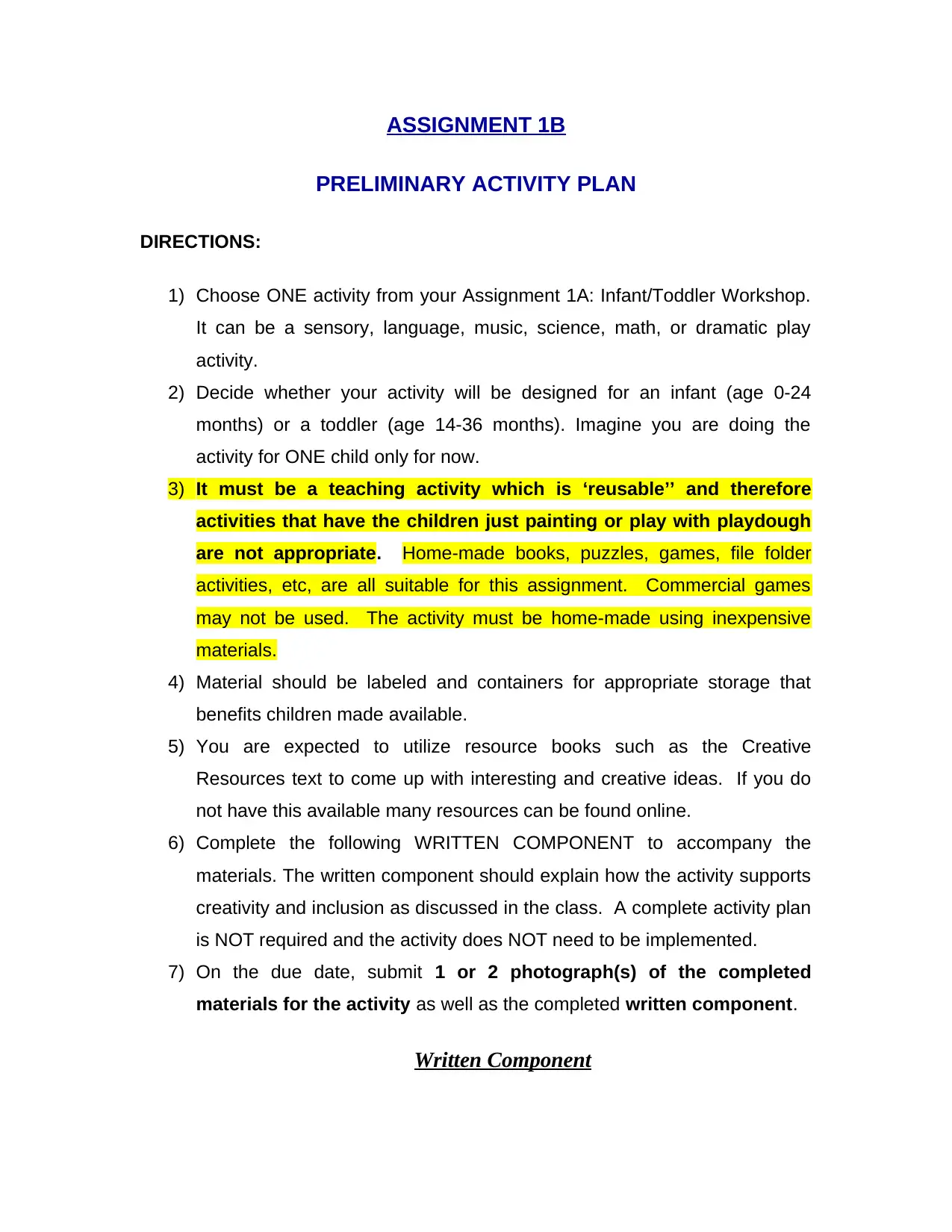
ASSIGNMENT 1B
PRELIMINARY ACTIVITY PLAN
DIRECTIONS:
1) Choose ONE activity from your Assignment 1A: Infant/Toddler Workshop.
It can be a sensory, language, music, science, math, or dramatic play
activity.
2) Decide whether your activity will be designed for an infant (age 0-24
months) or a toddler (age 14-36 months). Imagine you are doing the
activity for ONE child only for now.
3) It must be a teaching activity which is ‘reusable’’ and therefore
activities that have the children just painting or play with playdough
are not appropriate. Home-made books, puzzles, games, file folder
activities, etc, are all suitable for this assignment. Commercial games
may not be used. The activity must be home-made using inexpensive
materials.
4) Material should be labeled and containers for appropriate storage that
benefits children made available.
5) You are expected to utilize resource books such as the Creative
Resources text to come up with interesting and creative ideas. If you do
not have this available many resources can be found online.
6) Complete the following WRITTEN COMPONENT to accompany the
materials. The written component should explain how the activity supports
creativity and inclusion as discussed in the class. A complete activity plan
is NOT required and the activity does NOT need to be implemented.
7) On the due date, submit 1 or 2 photograph(s) of the completed
materials for the activity as well as the completed written component.
Written Component
PRELIMINARY ACTIVITY PLAN
DIRECTIONS:
1) Choose ONE activity from your Assignment 1A: Infant/Toddler Workshop.
It can be a sensory, language, music, science, math, or dramatic play
activity.
2) Decide whether your activity will be designed for an infant (age 0-24
months) or a toddler (age 14-36 months). Imagine you are doing the
activity for ONE child only for now.
3) It must be a teaching activity which is ‘reusable’’ and therefore
activities that have the children just painting or play with playdough
are not appropriate. Home-made books, puzzles, games, file folder
activities, etc, are all suitable for this assignment. Commercial games
may not be used. The activity must be home-made using inexpensive
materials.
4) Material should be labeled and containers for appropriate storage that
benefits children made available.
5) You are expected to utilize resource books such as the Creative
Resources text to come up with interesting and creative ideas. If you do
not have this available many resources can be found online.
6) Complete the following WRITTEN COMPONENT to accompany the
materials. The written component should explain how the activity supports
creativity and inclusion as discussed in the class. A complete activity plan
is NOT required and the activity does NOT need to be implemented.
7) On the due date, submit 1 or 2 photograph(s) of the completed
materials for the activity as well as the completed written component.
Written Component
Paraphrase This Document
Need a fresh take? Get an instant paraphrase of this document with our AI Paraphraser
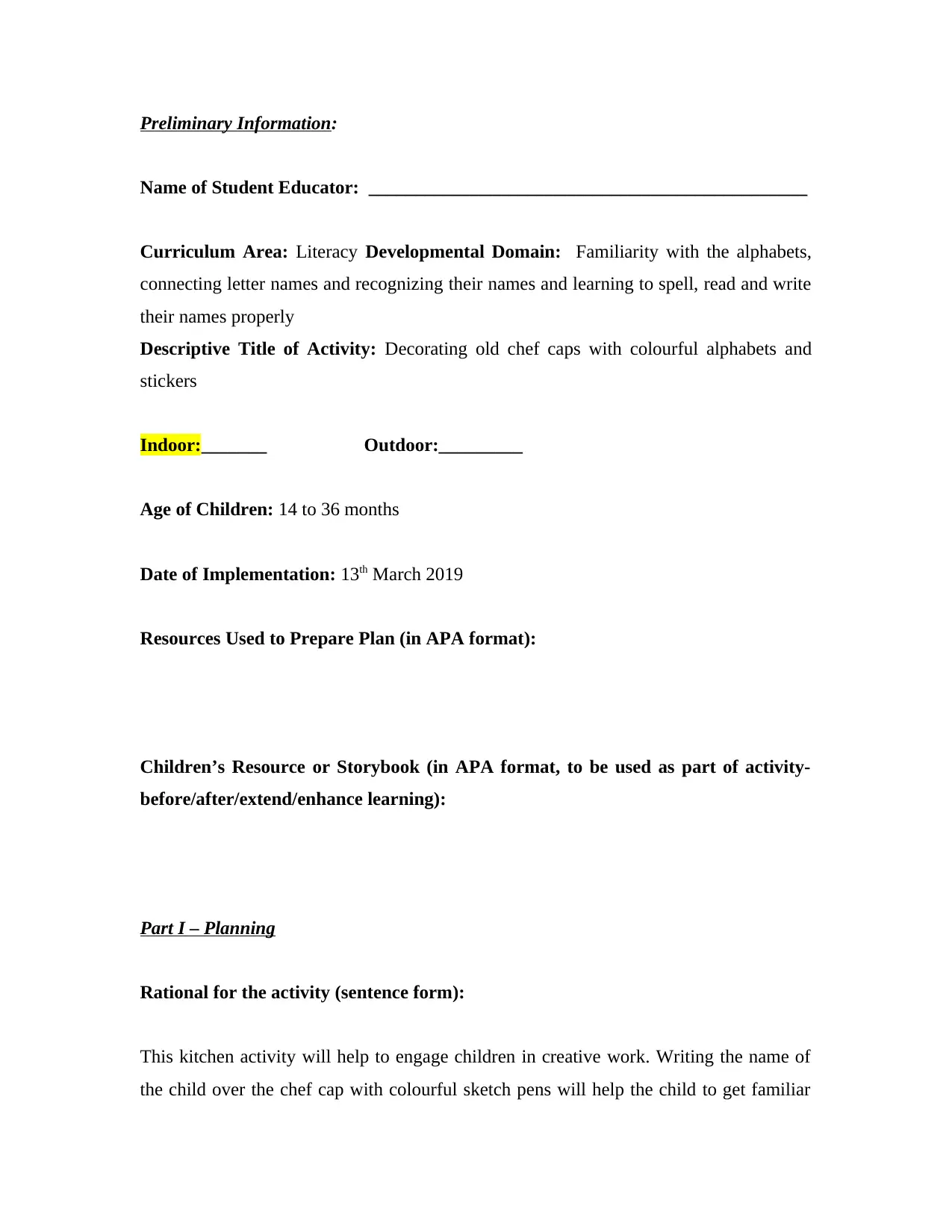
Preliminary Information:
Name of Student Educator: _______________________________________________
Curriculum Area: Literacy Developmental Domain: Familiarity with the alphabets,
connecting letter names and recognizing their names and learning to spell, read and write
their names properly
Descriptive Title of Activity: Decorating old chef caps with colourful alphabets and
stickers
Indoor:_______ Outdoor:_________
Age of Children: 14 to 36 months
Date of Implementation: 13th March 2019
Resources Used to Prepare Plan (in APA format):
Children’s Resource or Storybook (in APA format, to be used as part of activity-
before/after/extend/enhance learning):
Part I – Planning
Rational for the activity (sentence form):
This kitchen activity will help to engage children in creative work. Writing the name of
the child over the chef cap with colourful sketch pens will help the child to get familiar
Name of Student Educator: _______________________________________________
Curriculum Area: Literacy Developmental Domain: Familiarity with the alphabets,
connecting letter names and recognizing their names and learning to spell, read and write
their names properly
Descriptive Title of Activity: Decorating old chef caps with colourful alphabets and
stickers
Indoor:_______ Outdoor:_________
Age of Children: 14 to 36 months
Date of Implementation: 13th March 2019
Resources Used to Prepare Plan (in APA format):
Children’s Resource or Storybook (in APA format, to be used as part of activity-
before/after/extend/enhance learning):
Part I – Planning
Rational for the activity (sentence form):
This kitchen activity will help to engage children in creative work. Writing the name of
the child over the chef cap with colourful sketch pens will help the child to get familiar
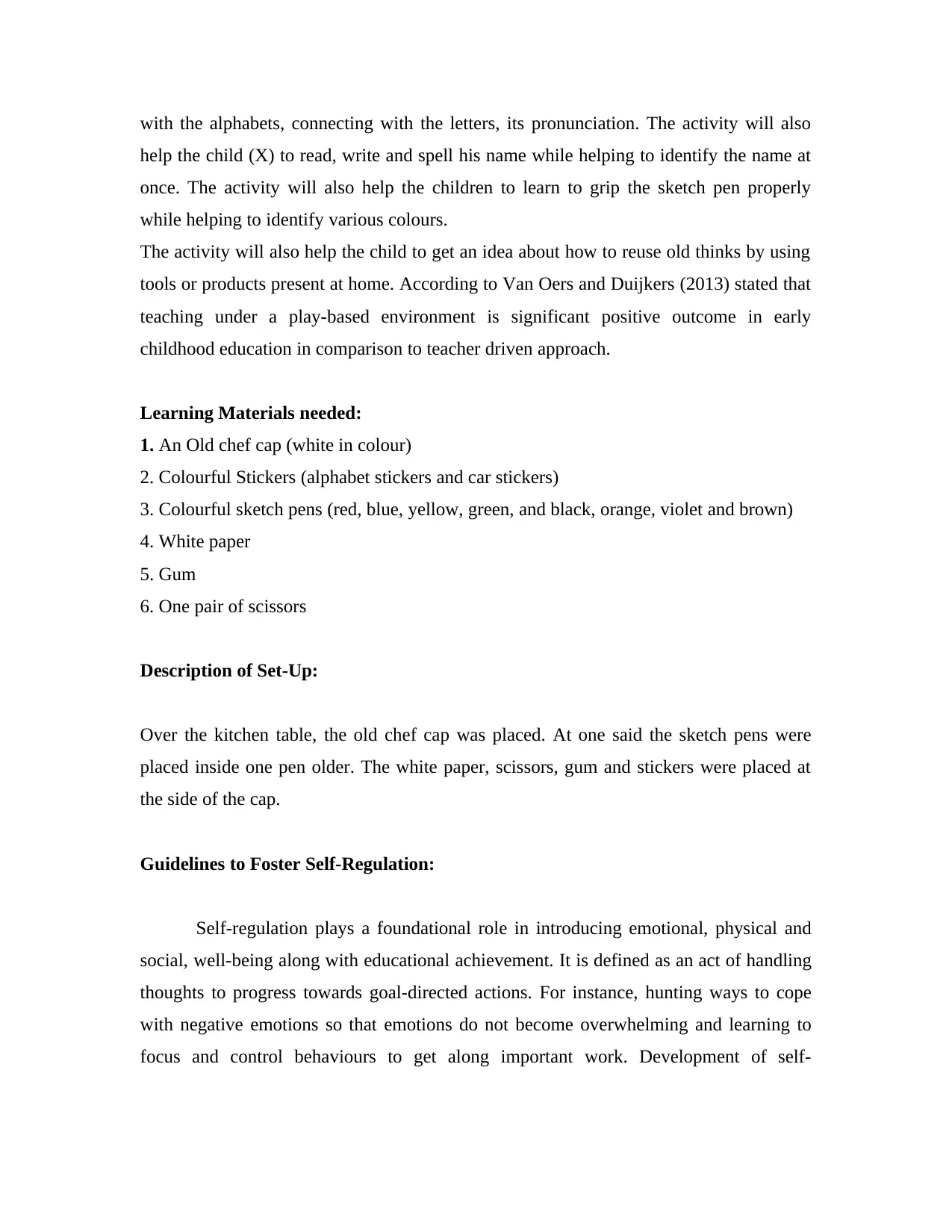
with the alphabets, connecting with the letters, its pronunciation. The activity will also
help the child (X) to read, write and spell his name while helping to identify the name at
once. The activity will also help the children to learn to grip the sketch pen properly
while helping to identify various colours.
The activity will also help the child to get an idea about how to reuse old thinks by using
tools or products present at home. According to Van Oers and Duijkers (2013) stated that
teaching under a play-based environment is significant positive outcome in early
childhood education in comparison to teacher driven approach.
Learning Materials needed:
1. An Old chef cap (white in colour)
2. Colourful Stickers (alphabet stickers and car stickers)
3. Colourful sketch pens (red, blue, yellow, green, and black, orange, violet and brown)
4. White paper
5. Gum
6. One pair of scissors
Description of Set-Up:
Over the kitchen table, the old chef cap was placed. At one said the sketch pens were
placed inside one pen older. The white paper, scissors, gum and stickers were placed at
the side of the cap.
Guidelines to Foster Self-Regulation:
Self-regulation plays a foundational role in introducing emotional, physical and
social, well-being along with educational achievement. It is defined as an act of handling
thoughts to progress towards goal-directed actions. For instance, hunting ways to cope
with negative emotions so that emotions do not become overwhelming and learning to
focus and control behaviours to get along important work. Development of self-
help the child (X) to read, write and spell his name while helping to identify the name at
once. The activity will also help the children to learn to grip the sketch pen properly
while helping to identify various colours.
The activity will also help the child to get an idea about how to reuse old thinks by using
tools or products present at home. According to Van Oers and Duijkers (2013) stated that
teaching under a play-based environment is significant positive outcome in early
childhood education in comparison to teacher driven approach.
Learning Materials needed:
1. An Old chef cap (white in colour)
2. Colourful Stickers (alphabet stickers and car stickers)
3. Colourful sketch pens (red, blue, yellow, green, and black, orange, violet and brown)
4. White paper
5. Gum
6. One pair of scissors
Description of Set-Up:
Over the kitchen table, the old chef cap was placed. At one said the sketch pens were
placed inside one pen older. The white paper, scissors, gum and stickers were placed at
the side of the cap.
Guidelines to Foster Self-Regulation:
Self-regulation plays a foundational role in introducing emotional, physical and
social, well-being along with educational achievement. It is defined as an act of handling
thoughts to progress towards goal-directed actions. For instance, hunting ways to cope
with negative emotions so that emotions do not become overwhelming and learning to
focus and control behaviours to get along important work. Development of self-
⊘ This is a preview!⊘
Do you want full access?
Subscribe today to unlock all pages.

Trusted by 1+ million students worldwide
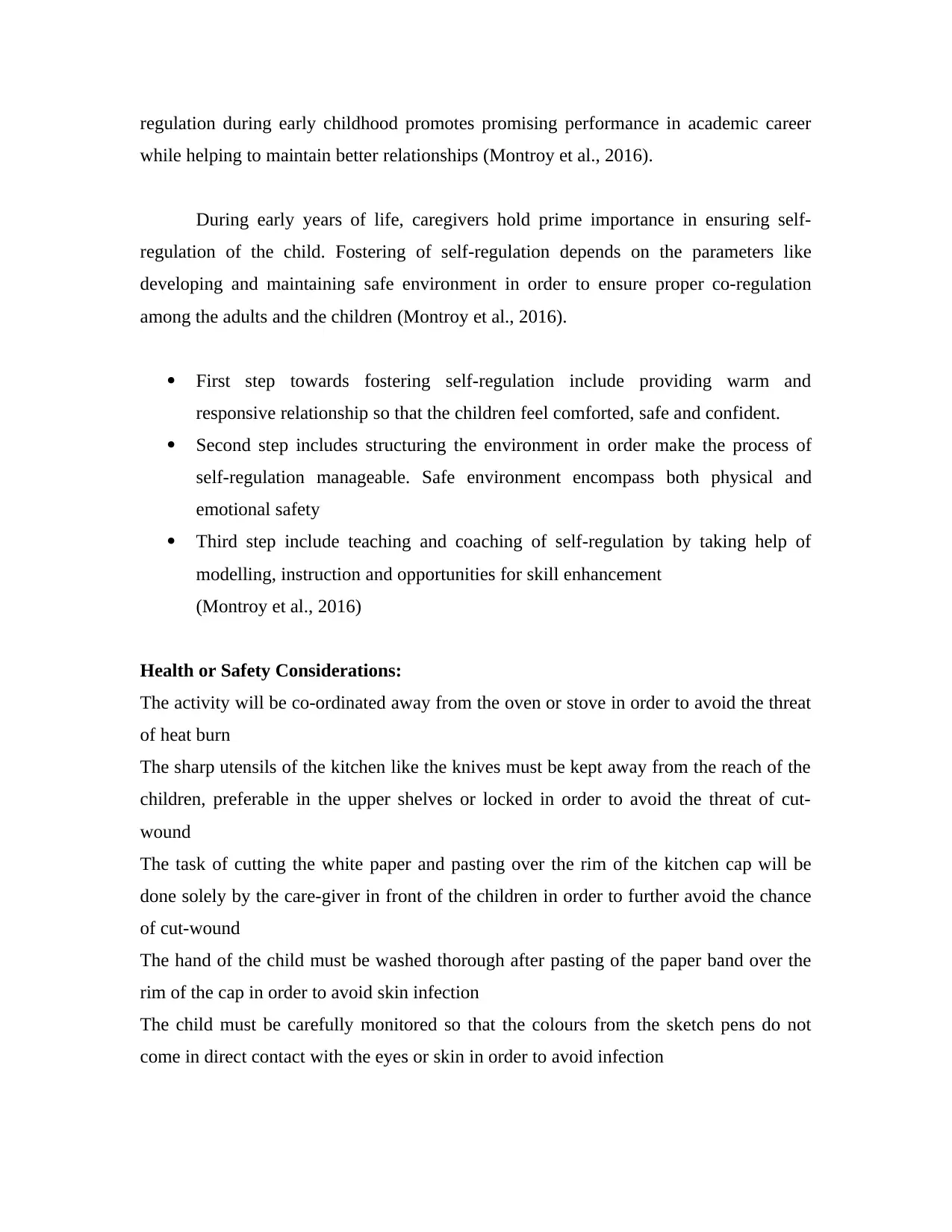
regulation during early childhood promotes promising performance in academic career
while helping to maintain better relationships (Montroy et al., 2016).
During early years of life, caregivers hold prime importance in ensuring self-
regulation of the child. Fostering of self-regulation depends on the parameters like
developing and maintaining safe environment in order to ensure proper co-regulation
among the adults and the children (Montroy et al., 2016).
First step towards fostering self-regulation include providing warm and
responsive relationship so that the children feel comforted, safe and confident.
Second step includes structuring the environment in order make the process of
self-regulation manageable. Safe environment encompass both physical and
emotional safety
Third step include teaching and coaching of self-regulation by taking help of
modelling, instruction and opportunities for skill enhancement
(Montroy et al., 2016)
Health or Safety Considerations:
The activity will be co-ordinated away from the oven or stove in order to avoid the threat
of heat burn
The sharp utensils of the kitchen like the knives must be kept away from the reach of the
children, preferable in the upper shelves or locked in order to avoid the threat of cut-
wound
The task of cutting the white paper and pasting over the rim of the kitchen cap will be
done solely by the care-giver in front of the children in order to further avoid the chance
of cut-wound
The hand of the child must be washed thorough after pasting of the paper band over the
rim of the cap in order to avoid skin infection
The child must be carefully monitored so that the colours from the sketch pens do not
come in direct contact with the eyes or skin in order to avoid infection
while helping to maintain better relationships (Montroy et al., 2016).
During early years of life, caregivers hold prime importance in ensuring self-
regulation of the child. Fostering of self-regulation depends on the parameters like
developing and maintaining safe environment in order to ensure proper co-regulation
among the adults and the children (Montroy et al., 2016).
First step towards fostering self-regulation include providing warm and
responsive relationship so that the children feel comforted, safe and confident.
Second step includes structuring the environment in order make the process of
self-regulation manageable. Safe environment encompass both physical and
emotional safety
Third step include teaching and coaching of self-regulation by taking help of
modelling, instruction and opportunities for skill enhancement
(Montroy et al., 2016)
Health or Safety Considerations:
The activity will be co-ordinated away from the oven or stove in order to avoid the threat
of heat burn
The sharp utensils of the kitchen like the knives must be kept away from the reach of the
children, preferable in the upper shelves or locked in order to avoid the threat of cut-
wound
The task of cutting the white paper and pasting over the rim of the kitchen cap will be
done solely by the care-giver in front of the children in order to further avoid the chance
of cut-wound
The hand of the child must be washed thorough after pasting of the paper band over the
rim of the cap in order to avoid skin infection
The child must be carefully monitored so that the colours from the sketch pens do not
come in direct contact with the eyes or skin in order to avoid infection
Paraphrase This Document
Need a fresh take? Get an instant paraphrase of this document with our AI Paraphraser
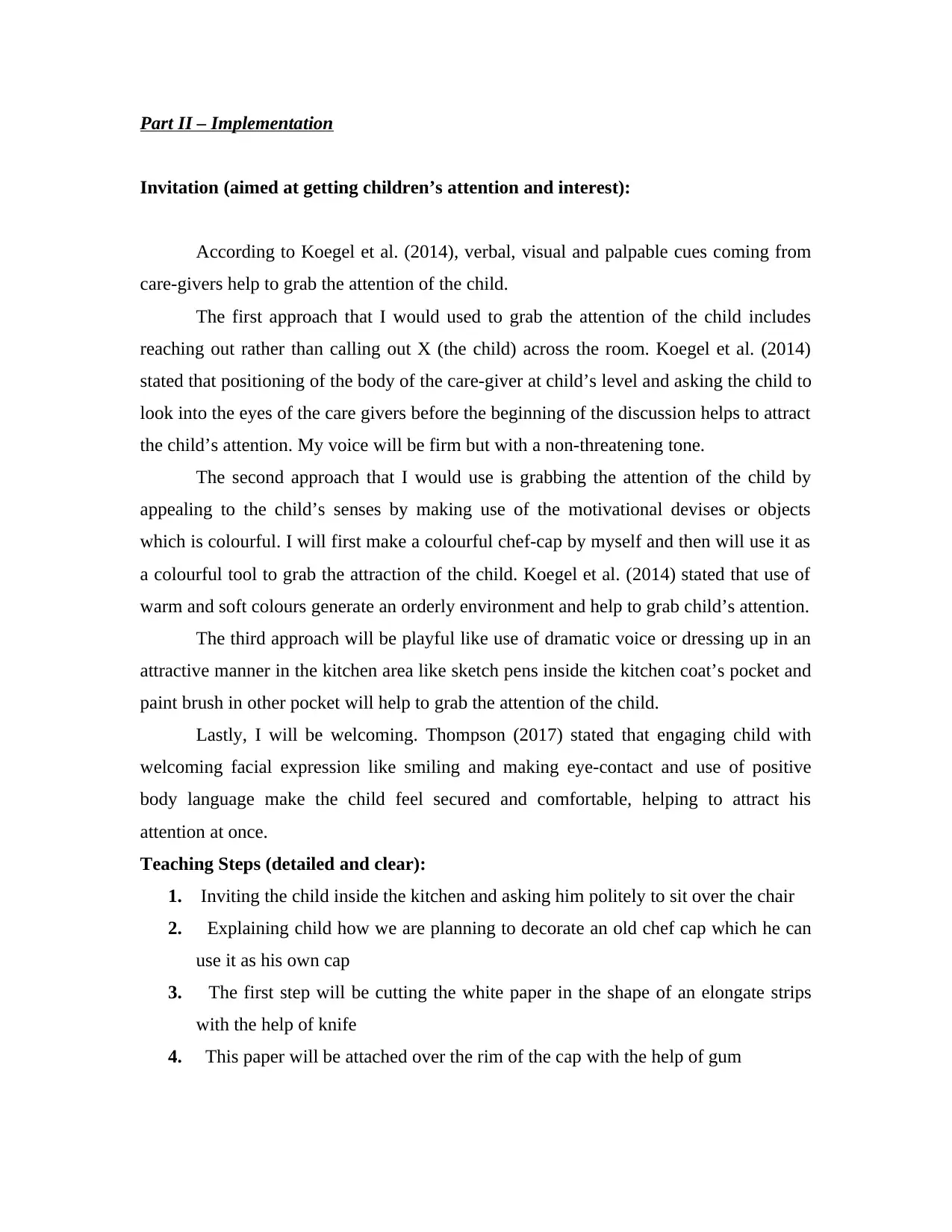
Part II – Implementation
Invitation (aimed at getting children’s attention and interest):
According to Koegel et al. (2014), verbal, visual and palpable cues coming from
care-givers help to grab the attention of the child.
The first approach that I would used to grab the attention of the child includes
reaching out rather than calling out X (the child) across the room. Koegel et al. (2014)
stated that positioning of the body of the care-giver at child’s level and asking the child to
look into the eyes of the care givers before the beginning of the discussion helps to attract
the child’s attention. My voice will be firm but with a non-threatening tone.
The second approach that I would use is grabbing the attention of the child by
appealing to the child’s senses by making use of the motivational devises or objects
which is colourful. I will first make a colourful chef-cap by myself and then will use it as
a colourful tool to grab the attraction of the child. Koegel et al. (2014) stated that use of
warm and soft colours generate an orderly environment and help to grab child’s attention.
The third approach will be playful like use of dramatic voice or dressing up in an
attractive manner in the kitchen area like sketch pens inside the kitchen coat’s pocket and
paint brush in other pocket will help to grab the attention of the child.
Lastly, I will be welcoming. Thompson (2017) stated that engaging child with
welcoming facial expression like smiling and making eye-contact and use of positive
body language make the child feel secured and comfortable, helping to attract his
attention at once.
Teaching Steps (detailed and clear):
1. Inviting the child inside the kitchen and asking him politely to sit over the chair
2. Explaining child how we are planning to decorate an old chef cap which he can
use it as his own cap
3. The first step will be cutting the white paper in the shape of an elongate strips
with the help of knife
4. This paper will be attached over the rim of the cap with the help of gum
Invitation (aimed at getting children’s attention and interest):
According to Koegel et al. (2014), verbal, visual and palpable cues coming from
care-givers help to grab the attention of the child.
The first approach that I would used to grab the attention of the child includes
reaching out rather than calling out X (the child) across the room. Koegel et al. (2014)
stated that positioning of the body of the care-giver at child’s level and asking the child to
look into the eyes of the care givers before the beginning of the discussion helps to attract
the child’s attention. My voice will be firm but with a non-threatening tone.
The second approach that I would use is grabbing the attention of the child by
appealing to the child’s senses by making use of the motivational devises or objects
which is colourful. I will first make a colourful chef-cap by myself and then will use it as
a colourful tool to grab the attraction of the child. Koegel et al. (2014) stated that use of
warm and soft colours generate an orderly environment and help to grab child’s attention.
The third approach will be playful like use of dramatic voice or dressing up in an
attractive manner in the kitchen area like sketch pens inside the kitchen coat’s pocket and
paint brush in other pocket will help to grab the attention of the child.
Lastly, I will be welcoming. Thompson (2017) stated that engaging child with
welcoming facial expression like smiling and making eye-contact and use of positive
body language make the child feel secured and comfortable, helping to attract his
attention at once.
Teaching Steps (detailed and clear):
1. Inviting the child inside the kitchen and asking him politely to sit over the chair
2. Explaining child how we are planning to decorate an old chef cap which he can
use it as his own cap
3. The first step will be cutting the white paper in the shape of an elongate strips
with the help of knife
4. This paper will be attached over the rim of the cap with the help of gum
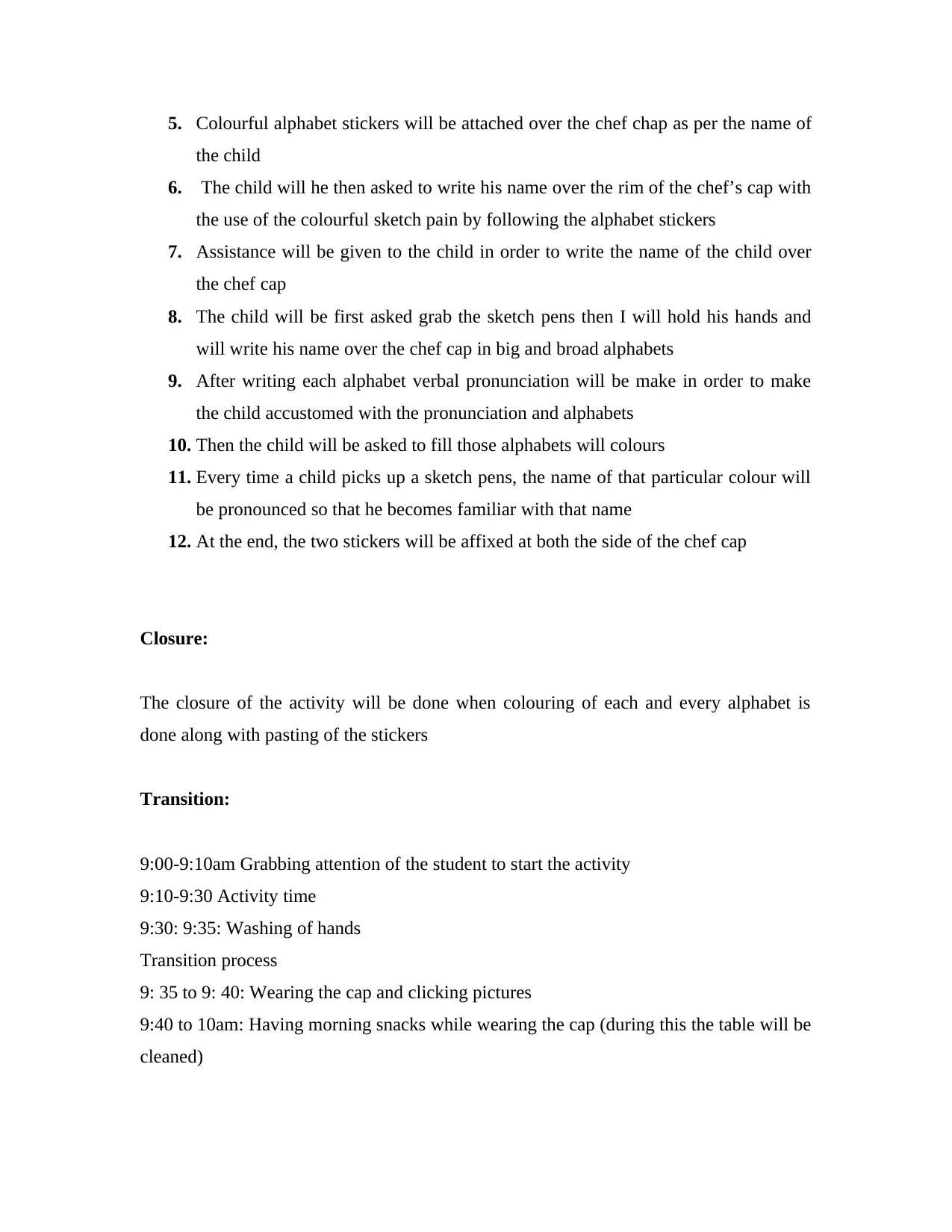
5. Colourful alphabet stickers will be attached over the chef chap as per the name of
the child
6. The child will he then asked to write his name over the rim of the chef’s cap with
the use of the colourful sketch pain by following the alphabet stickers
7. Assistance will be given to the child in order to write the name of the child over
the chef cap
8. The child will be first asked grab the sketch pens then I will hold his hands and
will write his name over the chef cap in big and broad alphabets
9. After writing each alphabet verbal pronunciation will be make in order to make
the child accustomed with the pronunciation and alphabets
10. Then the child will be asked to fill those alphabets will colours
11. Every time a child picks up a sketch pens, the name of that particular colour will
be pronounced so that he becomes familiar with that name
12. At the end, the two stickers will be affixed at both the side of the chef cap
Closure:
The closure of the activity will be done when colouring of each and every alphabet is
done along with pasting of the stickers
Transition:
9:00-9:10am Grabbing attention of the student to start the activity
9:10-9:30 Activity time
9:30: 9:35: Washing of hands
Transition process
9: 35 to 9: 40: Wearing the cap and clicking pictures
9:40 to 10am: Having morning snacks while wearing the cap (during this the table will be
cleaned)
the child
6. The child will he then asked to write his name over the rim of the chef’s cap with
the use of the colourful sketch pain by following the alphabet stickers
7. Assistance will be given to the child in order to write the name of the child over
the chef cap
8. The child will be first asked grab the sketch pens then I will hold his hands and
will write his name over the chef cap in big and broad alphabets
9. After writing each alphabet verbal pronunciation will be make in order to make
the child accustomed with the pronunciation and alphabets
10. Then the child will be asked to fill those alphabets will colours
11. Every time a child picks up a sketch pens, the name of that particular colour will
be pronounced so that he becomes familiar with that name
12. At the end, the two stickers will be affixed at both the side of the chef cap
Closure:
The closure of the activity will be done when colouring of each and every alphabet is
done along with pasting of the stickers
Transition:
9:00-9:10am Grabbing attention of the student to start the activity
9:10-9:30 Activity time
9:30: 9:35: Washing of hands
Transition process
9: 35 to 9: 40: Wearing the cap and clicking pictures
9:40 to 10am: Having morning snacks while wearing the cap (during this the table will be
cleaned)
⊘ This is a preview!⊘
Do you want full access?
Subscribe today to unlock all pages.

Trusted by 1+ million students worldwide
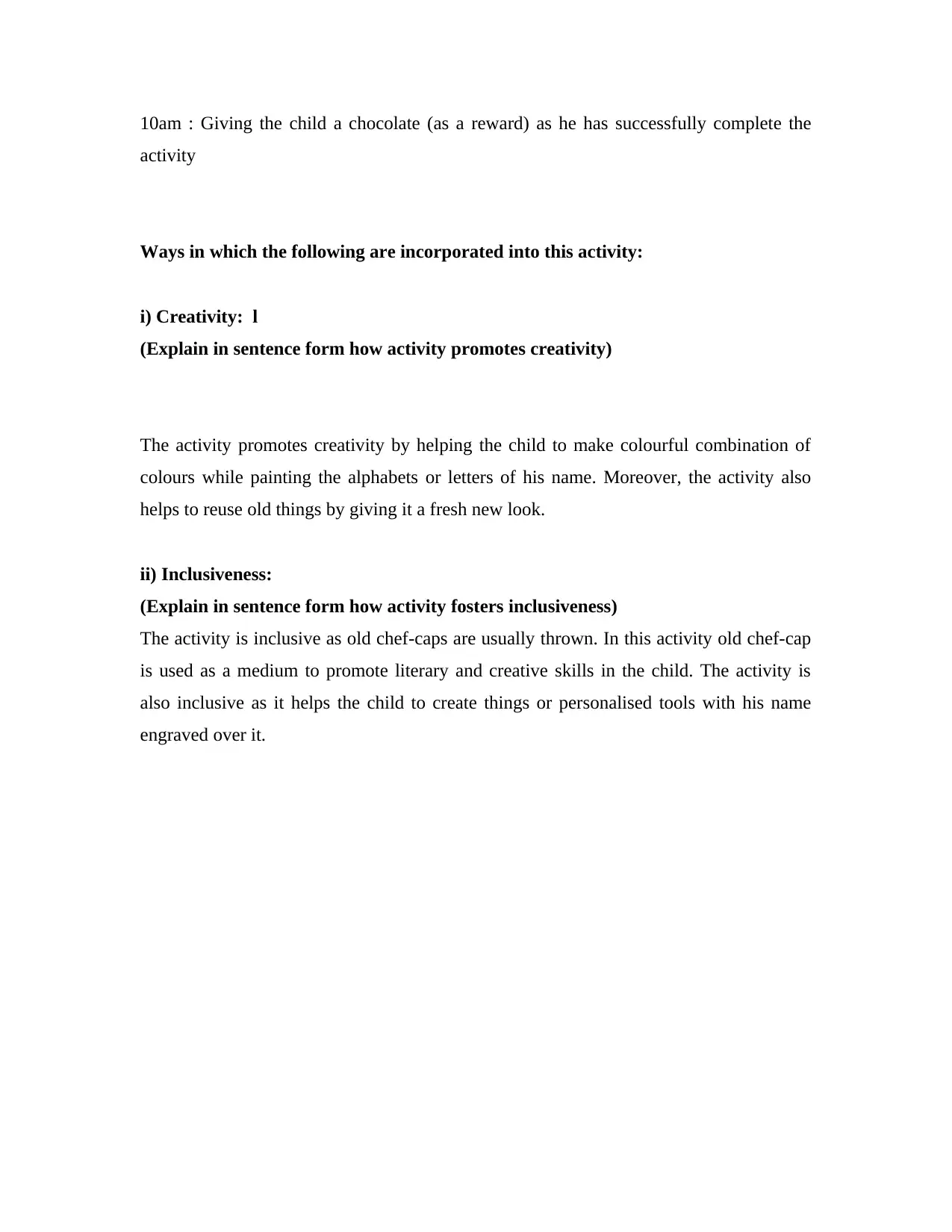
10am : Giving the child a chocolate (as a reward) as he has successfully complete the
activity
Ways in which the following are incorporated into this activity:
i) Creativity: l
(Explain in sentence form how activity promotes creativity)
The activity promotes creativity by helping the child to make colourful combination of
colours while painting the alphabets or letters of his name. Moreover, the activity also
helps to reuse old things by giving it a fresh new look.
ii) Inclusiveness:
(Explain in sentence form how activity fosters inclusiveness)
The activity is inclusive as old chef-caps are usually thrown. In this activity old chef-cap
is used as a medium to promote literary and creative skills in the child. The activity is
also inclusive as it helps the child to create things or personalised tools with his name
engraved over it.
activity
Ways in which the following are incorporated into this activity:
i) Creativity: l
(Explain in sentence form how activity promotes creativity)
The activity promotes creativity by helping the child to make colourful combination of
colours while painting the alphabets or letters of his name. Moreover, the activity also
helps to reuse old things by giving it a fresh new look.
ii) Inclusiveness:
(Explain in sentence form how activity fosters inclusiveness)
The activity is inclusive as old chef-caps are usually thrown. In this activity old chef-cap
is used as a medium to promote literary and creative skills in the child. The activity is
also inclusive as it helps the child to create things or personalised tools with his name
engraved over it.
Paraphrase This Document
Need a fresh take? Get an instant paraphrase of this document with our AI Paraphraser
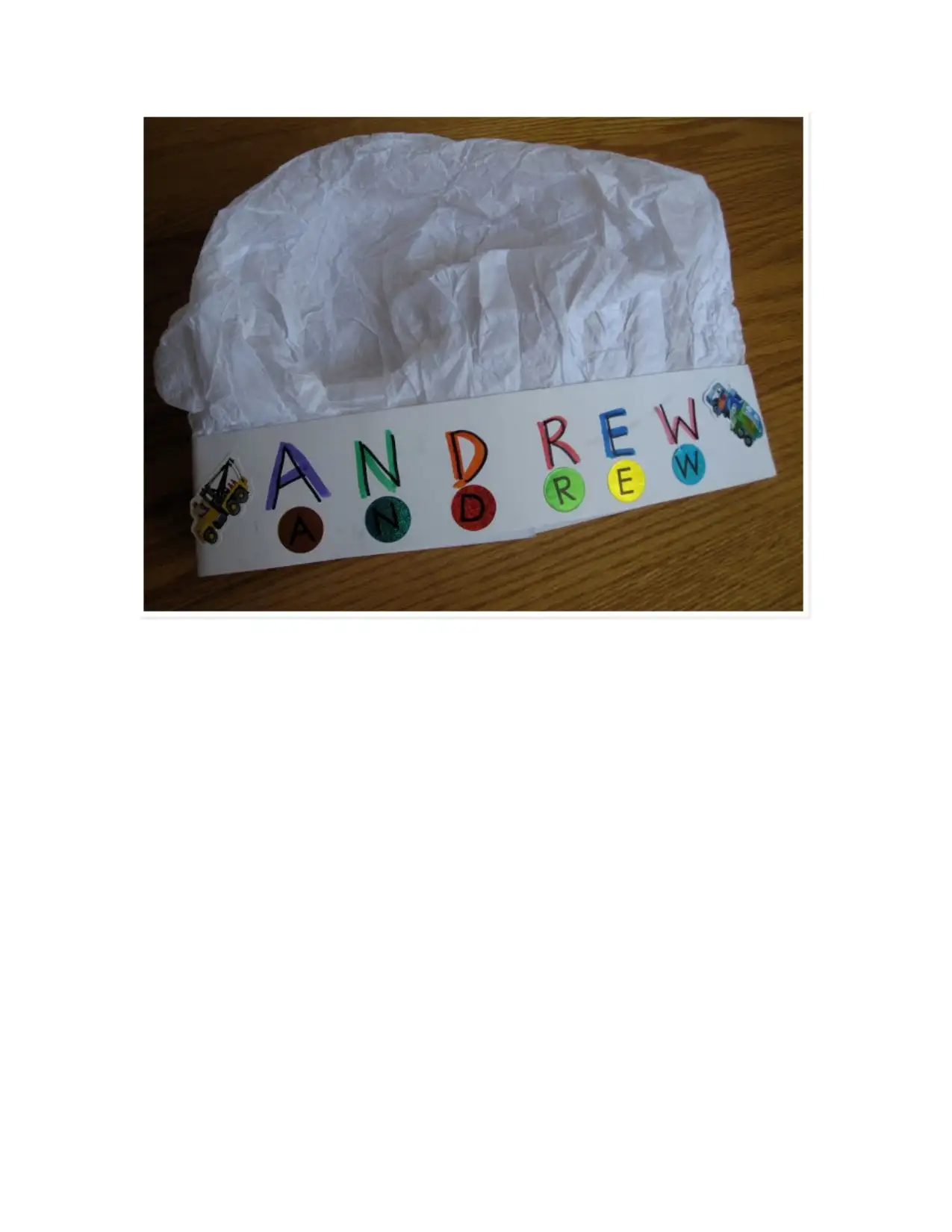
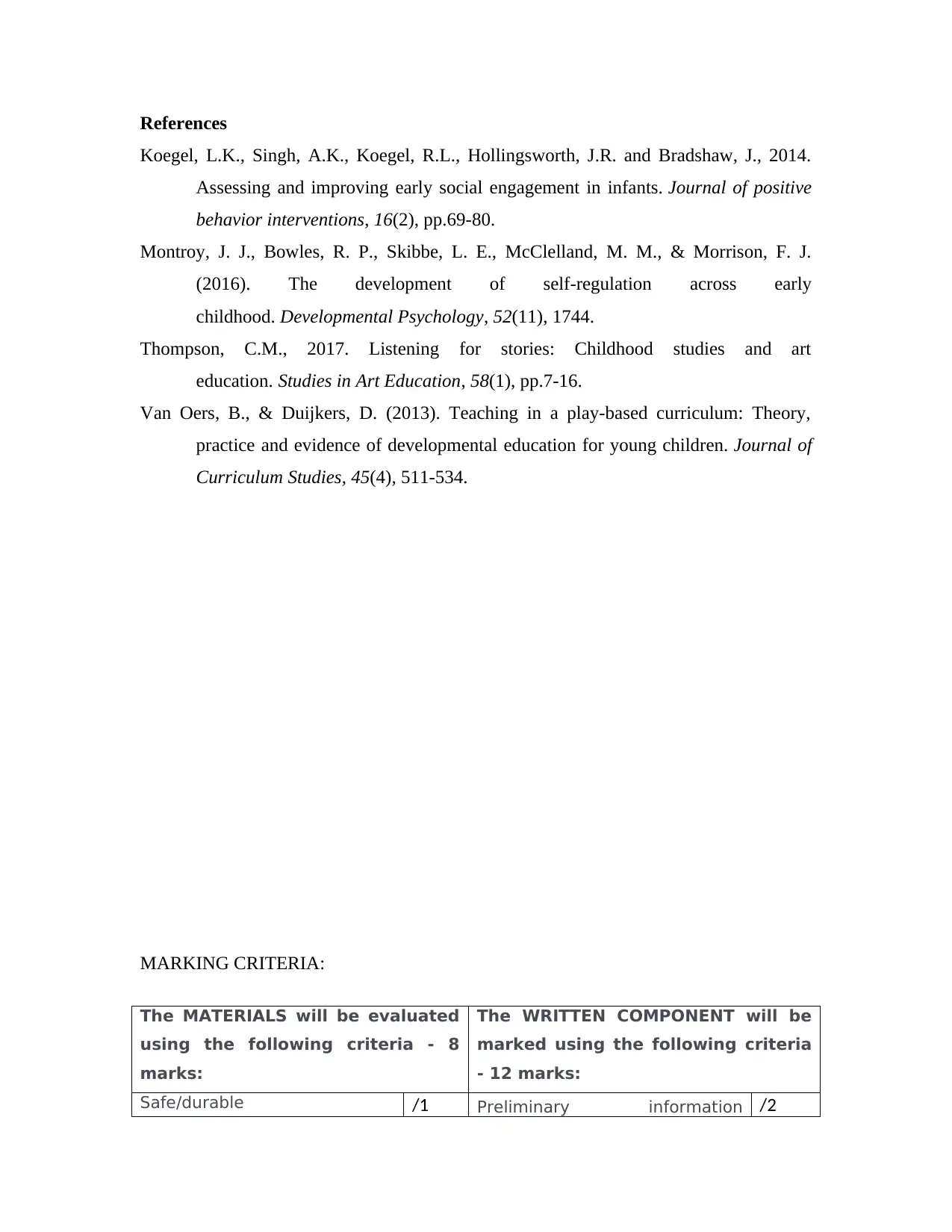
References
Koegel, L.K., Singh, A.K., Koegel, R.L., Hollingsworth, J.R. and Bradshaw, J., 2014.
Assessing and improving early social engagement in infants. Journal of positive
behavior interventions, 16(2), pp.69-80.
Montroy, J. J., Bowles, R. P., Skibbe, L. E., McClelland, M. M., & Morrison, F. J.
(2016). The development of self-regulation across early
childhood. Developmental Psychology, 52(11), 1744.
Thompson, C.M., 2017. Listening for stories: Childhood studies and art
education. Studies in Art Education, 58(1), pp.7-16.
Van Oers, B., & Duijkers, D. (2013). Teaching in a play-based curriculum: Theory,
practice and evidence of developmental education for young children. Journal of
Curriculum Studies, 45(4), 511-534.
MARKING CRITERIA:
The MATERIALS will be evaluated
using the following criteria - 8
marks:
The WRITTEN COMPONENT will be
marked using the following criteria
- 12 marks:
Safe/durable /1 Preliminary information /2
Koegel, L.K., Singh, A.K., Koegel, R.L., Hollingsworth, J.R. and Bradshaw, J., 2014.
Assessing and improving early social engagement in infants. Journal of positive
behavior interventions, 16(2), pp.69-80.
Montroy, J. J., Bowles, R. P., Skibbe, L. E., McClelland, M. M., & Morrison, F. J.
(2016). The development of self-regulation across early
childhood. Developmental Psychology, 52(11), 1744.
Thompson, C.M., 2017. Listening for stories: Childhood studies and art
education. Studies in Art Education, 58(1), pp.7-16.
Van Oers, B., & Duijkers, D. (2013). Teaching in a play-based curriculum: Theory,
practice and evidence of developmental education for young children. Journal of
Curriculum Studies, 45(4), 511-534.
MARKING CRITERIA:
The MATERIALS will be evaluated
using the following criteria - 8
marks:
The WRITTEN COMPONENT will be
marked using the following criteria
- 12 marks:
Safe/durable /1 Preliminary information /2
⊘ This is a preview!⊘
Do you want full access?
Subscribe today to unlock all pages.

Trusted by 1+ million students worldwide
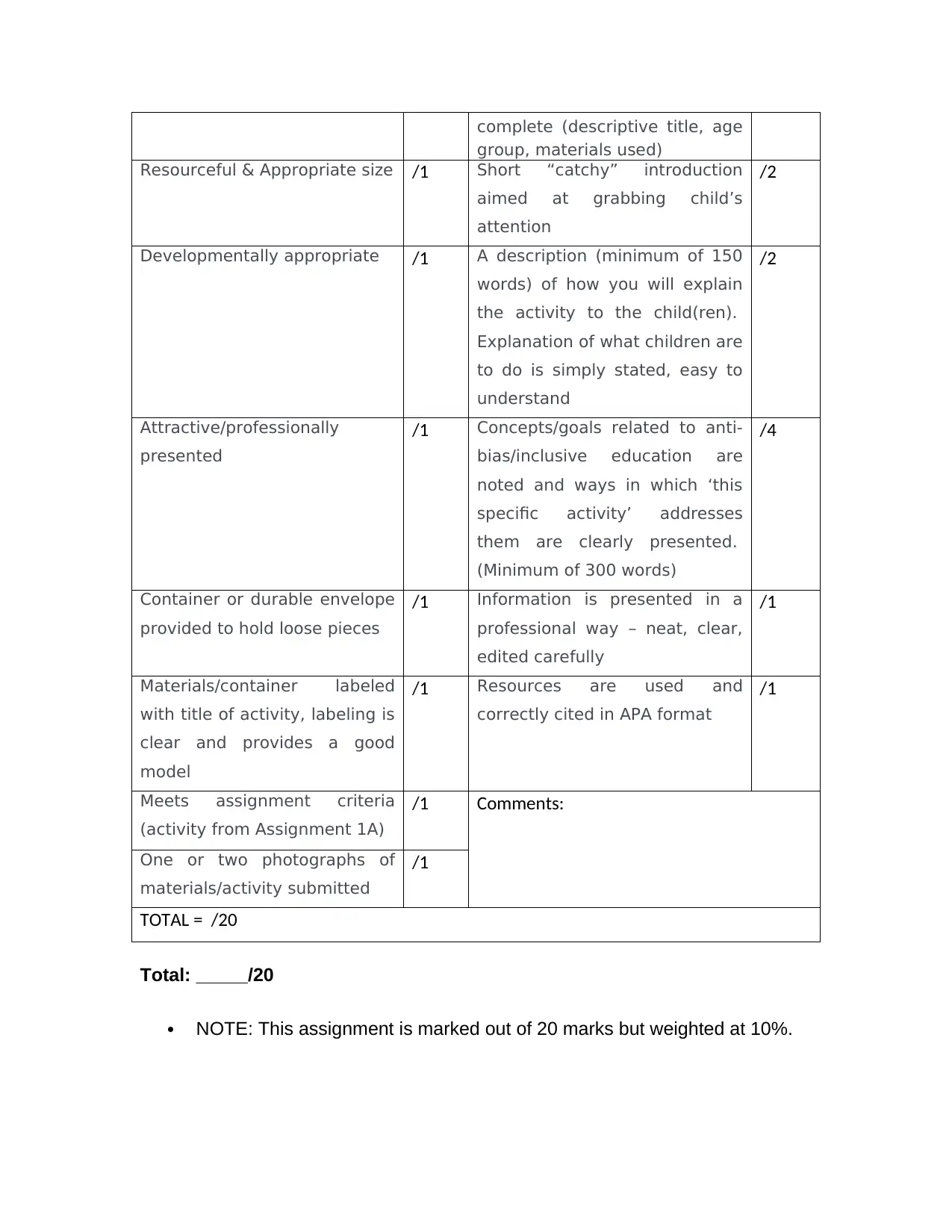
complete (descriptive title, age
group, materials used)
Resourceful & Appropriate size /1 Short “catchy” introduction
aimed at grabbing child’s
attention
/2
Developmentally appropriate /1 A description (minimum of 150
words) of how you will explain
the activity to the child(ren).
Explanation of what children are
to do is simply stated, easy to
understand
/2
Attractive/professionally
presented
/1 Concepts/goals related to anti-
bias/inclusive education are
noted and ways in which ‘this
specific activity’ addresses
them are clearly presented.
(Minimum of 300 words)
/4
Container or durable envelope
provided to hold loose pieces
/1 Information is presented in a
professional way – neat, clear,
edited carefully
/1
Materials/container labeled
with title of activity, labeling is
clear and provides a good
model
/1 Resources are used and
correctly cited in APA format
/1
Meets assignment criteria
(activity from Assignment 1A)
/1 Comments:
One or two photographs of
materials/activity submitted
/1
TOTAL = /20
Total: _____/20
NOTE: This assignment is marked out of 20 marks but weighted at 10%.
group, materials used)
Resourceful & Appropriate size /1 Short “catchy” introduction
aimed at grabbing child’s
attention
/2
Developmentally appropriate /1 A description (minimum of 150
words) of how you will explain
the activity to the child(ren).
Explanation of what children are
to do is simply stated, easy to
understand
/2
Attractive/professionally
presented
/1 Concepts/goals related to anti-
bias/inclusive education are
noted and ways in which ‘this
specific activity’ addresses
them are clearly presented.
(Minimum of 300 words)
/4
Container or durable envelope
provided to hold loose pieces
/1 Information is presented in a
professional way – neat, clear,
edited carefully
/1
Materials/container labeled
with title of activity, labeling is
clear and provides a good
model
/1 Resources are used and
correctly cited in APA format
/1
Meets assignment criteria
(activity from Assignment 1A)
/1 Comments:
One or two photographs of
materials/activity submitted
/1
TOTAL = /20
Total: _____/20
NOTE: This assignment is marked out of 20 marks but weighted at 10%.
Paraphrase This Document
Need a fresh take? Get an instant paraphrase of this document with our AI Paraphraser

1 out of 11
Related Documents
Your All-in-One AI-Powered Toolkit for Academic Success.
+13062052269
info@desklib.com
Available 24*7 on WhatsApp / Email
![[object Object]](/_next/static/media/star-bottom.7253800d.svg)
Unlock your academic potential
Copyright © 2020–2025 A2Z Services. All Rights Reserved. Developed and managed by ZUCOL.



